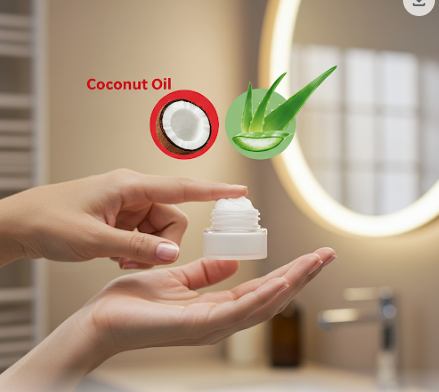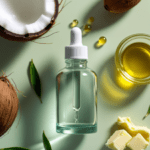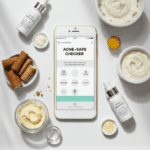What Does “Non-Comedogenic” Mean?
Non-comedogenic means that an ingredient or product will not block your pores. Scientists rate ingredients on a scale from 0 to 5:
- 0: Will not clog pores at all
- 1-2: Low risk
- 3-4: Moderate to high risk
- 5: Very high risk of clogging
| Rating | Pore Impact | Example Ingredients |
|---|---|---|
| 0 | Non-clogging | Glycerin, Hyaluronic Acid |
| 1–2 | Low chance of clogging | Jojoba Oil, Niacinamide |
| 3–4 | Can clog pores | Coconut Oil, Lanolin |
| 5 | Very high risk | Cocoa Butter, Isopropyl Myristate |
This scale helps you understand which ingredients are likely safe and which ones might cause breakouts. A simple glance at the table can guide you when shopping or checking product labels.
The Science Behind Comedogenicity
Your skin’s pores can get clogged when certain ingredients create a barrier that traps oil and dead skin cells. Here’s how it happens:
- Occlusive Ingredients: Heavy oils, like coconut oil and cocoa butter, coat the skin. This layer can trap sweat, dirt, and dead cells, leading to clogged pores.
- Silicones: Ingredients such as dimethicone, when used too much, can trap impurities.
- Misleading Natural Claims: A product might be labeled “natural,” but not all natural ingredients are safe for your pores. For instance, coconut oil, despite its natural origin, has a high comedogenic rating.
A study published in the Journal of the European Academy of Dermatology and Venereology found that some natural oils, though beneficial in other ways, rank high on the comedogenic scale. This shows that even natural substances must be carefully evaluated for pore safety.
| Ingredient | Comedogenic Rating (0-5) | Notes |
|---|---|---|
| Coconut Oil | 4 | While some people find it moisturizing, it’s known to clog pores for many. |
| Isopropyl Myristate | 4-5 | A common emollient and thickening agent. |
| Myristyl Myristate | 5 | An emollient and skin-conditioning agent. |
| Laureth-4 | 4 | An emulsifier and surfactant. |
| Stearic Acid | 2-3 | A fatty acid that can be comedogenic for some. |
| Palmitic Acid | 2 | Another fatty acid found in many products. |
| Oleic Acid | 2 | While generally considered beneficial, high concentrations might be comedogenic for some individuals. |
| Lanolin and its derivatives | 1-4 | A natural emollient, but can be irritating and comedogenic for some. Acetylated lanolin and alcohol are generally considered more comedogenic. |
| Mineral Oil | 0-1 | Generally considered low on the comedogenic scale, but some individuals may still experience issues. |
| Petrolatum | 0-1 | Similar to mineral oil, generally considered non-comedogenic. |
| Cocoa Butter | 4 | A rich emollient that can be pore-clogging for some. |
| Shea Butter | 0-2 | Generally considered low on the comedogenic scale, but some individuals may still react. Unrefined shea butter is often considered less comedogenic. |
| Sweet Almond Oil | 2 | A relatively mild oil, but can still cause issues for some acne-prone individuals. |
| Avocado Oil | 2 | A rich oil that might be comedogenic for some. |
| Wheat Germ Oil | 5 | Considered highly comedogenic for many. |
| Linseed Oil | 4 | Can be comedogenic for some skin types. |
| PEG-2 Stearate | 3 | An emulsifier. |
| Polyglyceryl-3 Diisostearate | 4 | An emulsifier. |
Important Considerations:
- Individual Skin: Everyone’s skin is different. An ingredient that is comedogenic for one person might not be for another.
- Concentration: The amount of an ingredient in a product matters. A small amount of a potentially comedogenic ingredient might not cause issues.
- Other Ingredients: The overall formulation of a product can influence its comedogenicity.
- Personal Testing: The best way to know if an ingredient clogs your pores is to test products on a small area of your skin.
This table is a general guideline. If you have acne-prone skin, it’s always best to look for products labeled “non-comedogenic” and to pay attention to how your skin reacts to different ingredients. You might also consider consulting a dermatologist for personalized advice.
Common Non-Comedogenic Ingredients: A Safe List
Here are some ingredients that dermatologists often recommend because they rarely cause breakouts:
- Hyaluronic Acid: Keeps skin hydrated without clogging pores.
- Niacinamide: Helps reduce inflammation and improves skin texture.
- Squalane: A lightweight oil that nourishes skin without creating blockages.
- Salicylic Acid: Helps exfoliate and clear pores by removing dead cells.
- Jojoba Oil: Mimics natural skin oils, rarely leading to blockages.
- Aloe Vera: Soothes skin and reduces irritation.
- Zinc Oxide: A common sunscreen ingredient that also calms the skin.
- Green Tea Extract: Packed with antioxidants and anti-inflammatory properties.
- Ceramides: Help restore and maintain the skin’s barrier.
- Benzoyl Peroxide: A key ingredient in many acne treatments.
Ingredients to Avoid: The Comedogenic List
Certain ingredients have a high tendency to block pores and lead to breakouts. Consider avoiding these:
- Coconut Oil: Rated 4 on the comedogenic scale.
- Cocoa Butter: Also rated 4, can clog pores in sensitive skin.
- Algae Extract: Can be problematic with a rating of 5.
- Lanolin: Rated 4, may lead to breakouts.
- Wheat Germ Oil: Scored a 5, known for pore blockage.
- Red Palm Oil: Rated 4, can cause skin issues.
- Isopropyl Myristate: With a rating of 5, it’s one of the top offenders.
| Ingredient | Comedogenic Rating | Comment |
|---|---|---|
| Coconut Oil | 4 | Common in natural products |
| Cocoa Butter | 4 | Often in moisturizers |
| Algae Extract | 5 | High risk for acne-prone skin |
| Lanolin | 4 | May cause irritation |
| Wheat Germ Oil | 5 | Heavy and pore-clogging |
| Red Palm Oil | 4 | Found in some hair products |
| Isopropyl Myristate | 5 | Frequently in synthetic products |
These ingredients should be flagged when you check a product’s ingredient list with our non comedogenic ingredient checker.
Meet the Non-Comedogenic Ingredient Checker Tool
What Does It Do?
Our non comedogenic ingredient checker is a free, easy-to-use online tool. Simply copy the ingredient list from your product label and paste it into the checker. The tool then highlights any high-risk ingredients and provides an instant rating for each.
- Instant Alerts: Clear warnings for ingredients that might clog pores.
- Science-Based Ratings: Uses a 0–5 scale based on research and dermatology studies.
- Mobile-Friendly: Check ingredients on the go.
How It Works – A Step-by-Step Guide
- Grab Your Product: Choose a moisturizer, serum, or makeup item.
- Copy the Ingredient List: Look at the label and copy the text.
- Paste and Analyze: Input the list into our tool and hit “Check.”
- Review the Results: The tool highlights risky ingredients, shows their comedogenic ratings, and suggests safer alternatives.
Example Walkthrough:
Input: “Cocos Nucifera (Coconut) Oil, Aqua, Glycerin, Niacinamide”
Output:
- Cocos Nucifera (Coconut) Oil: Flagged as high risk (Rating: 4)
- Glycerin & Niacinamide: Safe for your pores (Ratings: 0-1)
How to Use the Checker for a Healthier Skincare Routine
Using the non comedogenic ingredient checker is just one part of a better skincare routine. Here are some tips to optimize your daily regimen:
Read and Decode Labels
Many product labels use technical names. With our checker, you can understand which ingredients might cause issues, such as:
- PEG Compounds: Some synthetic compounds might irritate the skin.
- Synthetic Fragrances: Often hidden under general terms; check if your product includes them.
Layering Your Skincare
A proper routine often involves layering:
- Start Light: Apply thinner products like serums first.
- Follow with Creams: Then use heavier moisturizers if needed.
- Sun Protection: Always finish with a non-comedogenic sunscreen to protect your skin.
Patch Testing
Even with non comedogenic products, patch testing is key. Apply a small amount on your inner wrist or behind your ear, and wait 24 hours.
Track Your Skin
Keep a simple diary noting the products used, any breakouts, and changes in your skin’s condition. Over time, this can guide you to the best ingredients for your skin.
| Step | Product Type | Example Ingredients | Tip |
|---|---|---|---|
| 1. Cleanse | Gentle cleanser | Glycerin, Salicylic Acid | Avoid harsh scrubs |
| 2. Tone | Alcohol-free toner | Witch Hazel, Aloe Vera | Preps skin for serum |
| 3. Serum | Lightweight serum | Niacinamide, Hyaluronic Acid | Hydrates and soothes |
| 4. Moisturize | Non-comedogenic cream | Squalane, Ceramides | Locks in moisture |
| 5. Sunscreen | Broad-spectrum SPF 30+ | Zinc Oxide, Titanium Dioxide | Protects skin without clogging pores |
Research and Statistics That Back Up The Approach
Data supports the connection between ingredient safety and clearer skin. Here are a few studies and statistics:
- A 2012 study in the Journal of Cosmetic Dermatology examined the effects of various oils on acne-prone skin, showing that ingredients like coconut oil and isopropyl myristate have a higher risk of clogging pores.
- Nearly 46% of acne sufferers noted that product ingredients significantly affected their breakouts.
- Research emphasizes that understanding and choosing the right ingredients can help manage acne effectively.
Skincare Tips for a Non-Comedogenic Routine
Choose Products Carefully
Select products labeled as non-comedogenic. Use our checker as a second opinion. Even if a product is marketed for acne-prone skin, a quick scan of the ingredient list may reveal hidden comedogenic compounds.
Avoid Overloading Your Skin
Too many products can stress your skin. Stick with a few trusted items that work well together. This approach also makes it easier to pinpoint any ingredient causing a breakout.
Understand the Role of Each Ingredient
Not all oils and emollients are bad. Some, like jojoba oil, mimic your skin’s natural sebum and help balance oil production. Look for ingredients that hydrate without leaving a heavy residue.
Adjust Your Routine Seasonally
Your skin’s needs may change with the weather. In humid seasons, lighter products are often preferable; in dry weather, a richer moisturizer might be needed. Always check ingredients for comedogenic risks.
Consult a Dermatologist
While online tools and checklists help, nothing beats professional advice. A dermatologist can offer personalized recommendations based on your skin’s behavior and history.
FAQs About Non-Comedogenic Ingredients
Q1: Is shea butter non-comedogenic?
A: Yes. Research shows that shea butter generally falls in the 0–1 range on the comedogenic scale. However, if you have very sensitive skin, always perform a patch test.
Q2: Can non-comedogenic products still cause breakouts?
A: In rare cases, yes. Breakouts may result from allergies or a reaction to a combination of ingredients, even if each is rated low on the comedogenic scale.
Q3: How do I find non-comedogenic makeup?
A: Look for products with labels like “non-comedogenic” or use our non comedogenic ingredient checker. Many makeup brands now offer formulations that are tested for pore safety.
Q4: What role does a non comedogenic ingredient checker play?
A: It helps you quickly identify risky ingredients. It supports your efforts to maintain clear skin by flagging high-risk components, based on scientific research.
How to Optimize Your Product Searches
If you want to avoid pore-clogging ingredients, follow these steps:
- Read Reviews and Research: Check product reviews and research studies before buying. Resources like PubMed and the American Academy of Dermatology offer valuable insights.
- Use Advanced Search Tools: Leverage our checker tool for instant feedback—this saves time compared to manual research.
- Look for Certifications: Some products carry non-comedogenic certifications, helping you decide quickly if a product is right for you.
- Stay Updated: Ingredient research evolves. Our tool is updated weekly to provide the latest information.
Related Keywords: non comedogenic ingredient checker, comedogenic scale, non comedogenic makeup, safe skincare ingredients, acne-prone skin products.
Conclusion: Take Control of Your Skincare Routine
Breakouts are frustrating. They affect your confidence and daily life. With our Non Comedogenic Ingredient Checker, you can review your skincare products in minutes and identify ingredients that might harm your skin.
This guide provides the science, research, and visual tools to help you choose products wisely. With our free checker, you can shift from guesswork to a routine that supports your skin’s health. Check every ingredient, understand its rating, and pick products that keep your pores clear.
Clear skin is within reach. Whether you’re shopping for a new moisturizer or evaluating your current regimen, our tool and guide offer the detailed information you need. Explore the research links, review our charts and infographics, and share this guide with others on their journey to clearer skin.
Final Thoughts
Taking control of your skincare routine starts with knowledge. Our ingredient checker helps you decode complicated ingredient lists and make informed choices for clearer skin.
Each ingredient matters—from the lightest serum to the richest cream. Use our guide and checker to decode these roles and select products that work best for your skin type. With regular use of our tool and a focus on non-comedogenic products, you can reduce breakouts and build a routine that truly supports your skin.
Now that you have all the details, try our checker on your favorite products and see the difference. Your skin will thank you!

I’m a devoted organic skincare enthusiast, passionate about the natural, wholesome goodness that organic products bring to our skin.
Organic skincare isn’t just a hobby for me—it’s a lifestyle. Every product I use, recommend, and write about has been carefully chosen for its purity and effectiveness. Everything I write about is backed by scientific studies, dermatologists’ opinions, and user experiences.
I also excel at tackling skincare challenges with innovative, organic solutions.


